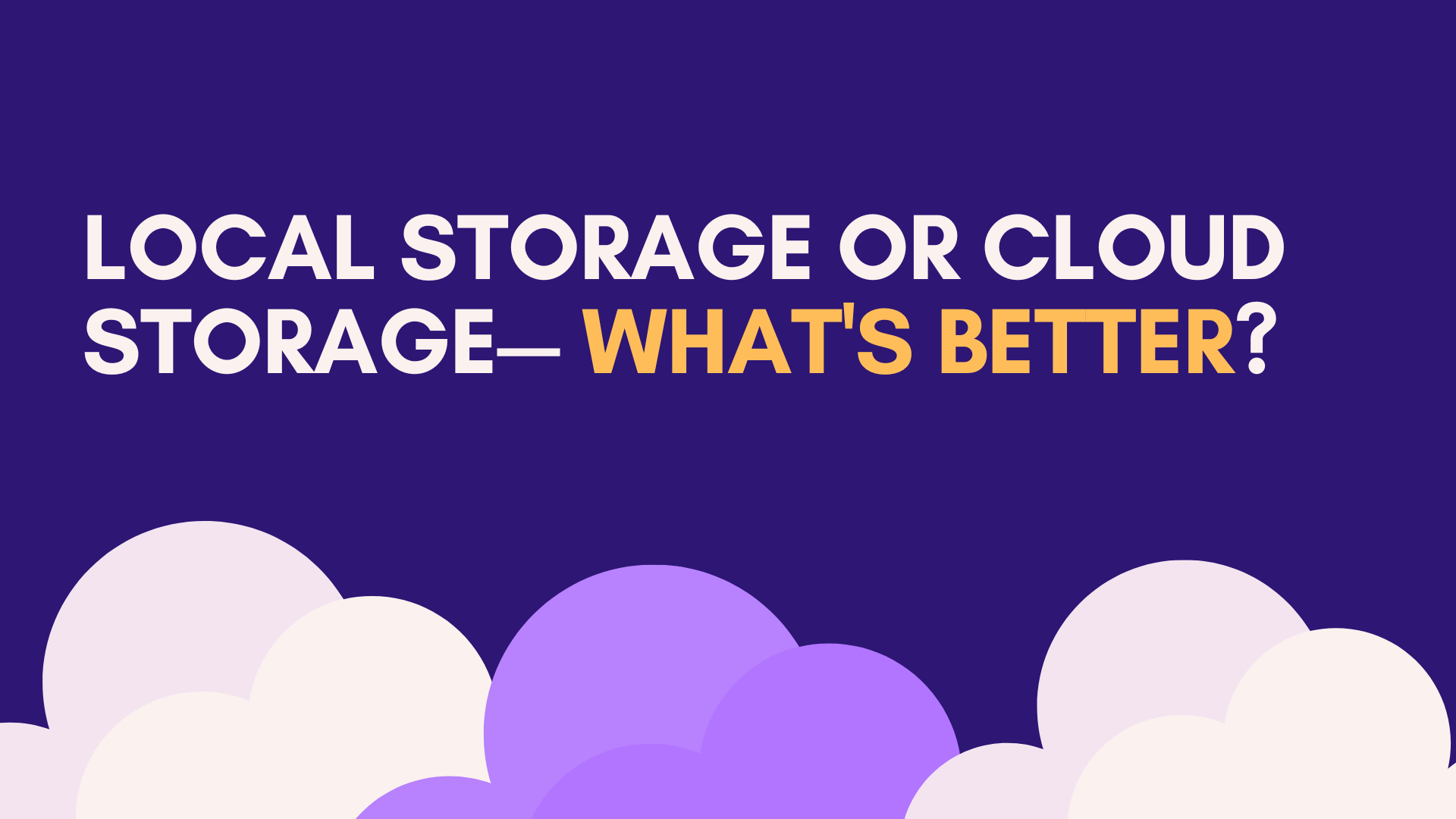Local Storage or Cloud Storage: Which one is better?

If you’ve ever asked yourself that question, you’re not alone. So what solution is best for your business and storing its data? Is it an on-location storage server, or are you better off storing your data on the cloud?
Well, the truth is no one solution is better than the other because no two data storage needs are the same. Therefore, it is impossible to say that a specific setup will solve all of your data storage problems. It depends on your particular needs and requirements, as well as the security needed surrounding those requirements.
So, how do you decide? First, let’s go through each option’s common advantages and disadvantages. Then you can decide which is right for you—starting with our preferred method for storing your data: On-premises or local storage (for obvious reasons).
Advantages of Local Storage
- Physically on-site, so you have full control: With your local storage server on-site, you have full control over your storage infrastructure.
You can set permissions, create file trees, set data quotas and buckets for specific users, and create permissions for user access. This functionality is also still available with the cloud, but you can have more rigorous controls when your storage servers are located at your business or home office.
It’s a common misconception that this takes a lot of work. Of course, some groundwork needs to be done to ensure that your systems are properly secured, but with a 45Drives storage server(s), you will have access to our dedicated support team that can help you any time our assistance is required.
- Local storage systems are easily adaptable & expandable: Adaptable how? Well, you typically do not run into unexpected paywalls or mechanisms that hinder your organization’s ability to store its ever-changing and growing data needs. An on-premises solution can mitigate the surprises that come with those fluctuations.
For example, need more storage space? You can easily increase the size of your infrastructure by adding another server or a few more drives into your server’s empty bays. Need better performance? Upgrade the components within your storage server or deploy a more favourable RAID type for your performance needs.
There are no surprise surcharges and no guesswork to project how much storage you will need in three months, six months, and beyond. Better yet, if you don’t know how much you’re going to grow but know you will be expanding over time, a clustered solution can be even more economical than periodically growing by adding new single servers.
- An on-premises storage solution helps to bolster your organization’s security posture:
Compliance measures for frameworks like HIPAA and GDPR, law enforcement and surveillance require very stringent data security controls. And, to reach certain levels of compliance, your data sometimes needs to be stored on-site — in a location that is easily accessible.
For example, law enforcement’s digital evidence, like crime scene photos, victim information, etc., cannot be stored on the cloud for many different reasons. Think of how detrimental it would be if crime scene evidence was stored on the cloud and the provider of that cloud storage was affected by a data breach. Not just the fact that those photos could get into the wrong hands but also that any trial resulting from that crime would need to be abandoned. The same goes for data like personal health records. There are many horror stories about data breaches, where personal records were exposed or sold on the dark web for ransom.
Securing your data at your location and having a dedicated team to monitor it regularly is hugely advantageous and provides extra peace of mind that cloud storage cannot always promise.
- No internet required: Unlike the cloud, an internet connection is not required for local storage. Therefore, your data can be accessed whenever you need it from your internal network without the worry of internet speeds, connectivity issues, or general reliability.
You also don’t have to worry about any additional costs associated with downloading your data or costs to upload more of it. Generally speaking, local storage is more reliable and is always accessible.
- Local storage can still have cloud storage: One of its big advantages is the ability to access and share data from the cloud easily. But an on-premises cloud can be made too. With the help of the S3 protocol, you can turn your local storage into its own cloud.
Having your own “cloud” at your location gives you the option of creating specialized buckets with their own unique links, similar to the way that cloud sharing works. Only individuals with that specific link can access data shared with them and work within the parameters of the quotas that have been assigned. These permissions can also get very granular, depending on how they are set up, and can operate exactly like an external cloud. It’s truly the best of both worlds.
- No hidden fees: As mentioned above, the cloud can come with a mix of hidden paywalls and fees. Of course, there can be some significant upfront costs with purchasing storage servers and the upkeep of those servers (general maintenance, power consumption, upgrades, etc.). But, once you have your storage infrastructure in place, there are no unforeseen costs when it comes to things like downloading your data, service charges, or unplanned spikes in the cost to store it all.
Similarly, if you want to increase your storage limits, you can customize your infrastructure to best suit your needs rather than paying prices that lock you in for specific periods. Worse than that, when using traditional cloud, switching your data from one provider to another isn’t easy—you have to download all of that data from one location and upload it to the next. This process is both time-consuming and potentially very expensive.
Disadvantages of local storage:
- Local storage requires physical space and often specialized IT staff: Having your storage solutions on-site can sometimes require the expertise of trained IT employees. The cloud is backed up automatically and constantly “running” in the background to guarantee that your data is always available. Particular redundancies and performance mechanisms must be implemented among your storage devices, therefore requiring IT professionals’ intervention and skilled services. Not every organization has the means to be able to afford this or the bandwidth from current staff to control it all, which can account for the reasons the cloud is put into action.
- Risk of unwanted internal access: Because your storage servers are physically at your location, you need to make sure that these servers are stationed in the proper areas based on your physical security policy. They should be locked away securely in separate rooms or at least in a space that does not see high traffic. Additionally, with local storage, there is an increased risk of data tampering, i.e., If it’s not protected with the necessary firewalls and encryption – that cloud services often provide – you are running a greater risk of that data getting into the wrong hands. Whether from an external source or a disgruntled employee who wants to do harm.
- Higher upfront costs to local storage: Getting started with cloud storage costs less than getting started with on-premises solutions. Especially if you’re using the cloud to back up your data (cold storage) and don’t necessarily need to access/download your data regularly—which is where cloud storage can become cost-prohibitive. Also, the more data you have, the more physical storage you need. So, the upfront investment can potentially be a barrier to install and manage.
- Physical servers are more susceptible to external damage: Keeping physical servers at the office or data center does come with the risk of losing them through external damage.
If a fire, flood, or building experiences structural damage, you’ve likely lost all of your data. And if you haven’t retrieved it, it can be very difficult.
*Here at 45Drives, we strongly suggest using the 3-2-1 data protection method.
Now, let’s go over some common advantages and disadvantages of cloud storage.
Advantages of cloud storage:
- Hands-off approach: With cloud storage, data management is virtually hands-off. Data sent to “the cloud” is backed up at regular intervals with almost no human intervention required. If your computer crashes? No need to panic – your data is safe. Unlike traditional local storage, you also don’t have to take your files with you. You don’t need to transport them from one location to the next physically.
- Your files are easily available: As long as you have access to reliable internet, your files will always be available, whether working from home or a coffee shop. And, with many people still working from home even today, cloud storage has also made collaborative learning and file sharing easier than ever!
- The cloud is easy to scale (with only a few gigabytes or terabytes): If you only have a small amount of data, the cloud is a great solution. Increasing the amount of data you have stored in the cloud is also painless. There are usually costs associated with doing this, of course, but adoption of cloud storage is still, by comparison, less expensive than local storage when you have small amounts of data.
- Worried about physical data loss? The cloud has you covered: If you’re only using cloud storage, no physical servers or external hard drives are kicking around. So, there’s little worry of losing your data to things like a fire, water damage, physical damage, etc., as there can be with on-premises storage.
Besides the cloud’s ease of use –just upload your data and forget about it – the comfort of knowing someone cannot physically walk away with your data is definitely one of the main selling points of the cloud for many people. The data centers owned by cloud storage providers have multiple redundancies to ensure that your data is always safe and accessible. They also employ a variety of additional security layers like encryption to further safeguard your files.
But, of course, the cloud comes with several drawbacks as well. Let’s look at some of them.
The disadvantages of cloud storage:
- Unexpected paywalls: Upfront costs of cloud storage can seem attractive. The relative cost per gigabyte, especially when you only have small amounts, can seem low compared to local storage costs. But the price tag begins to increase significantly as soon as you try downloading data that belongs to you already. Even uploading more data outside the scope of the package you purchased can see those costs start to climb higher.
Downloading your data from the cloud is called an egress charge. Companies have often been hit with thousands, sometimes even millions of dollars of unexpected costs connected to this action, a costly mistake that is easily overlooked.
Furthermore, one of the biggest cloud providers in the space has recently tightened its controls on the limits of its free tier offering. Not only is the free tier decreasing in size, but the costs of storage, in general, are going up. This might not seem like a huge deal; however, in the grand scheme of things, an increase of a cent or two for each GB stored can literally translate to very substantial losses and the slashing of budgets. Cloud storage is not ideal when you have large amounts of data. Yes, it’s a viable solution when you only have a few gigabytes. But when you get into the realm of tens of terabytes of data, it’s probably time to consider moving away from the cloud.
This is especially crucial for industries like research & education, where every dollar matters.
- Reliance on the internet: Cloud storage is exclusively online, meaning if you experience any internet downtime or disruption, your files are difficult to access. The performance of your internet can also affect your ability to access them. Slow download speeds and bottlenecks can dramatically affect data retrieval.
- Not all data can be stored on the cloud: We mentioned this briefly when we discussed on-premises storage, but it’s worth mentioning again that not all data is a candidate for cloud storage, especially sensitive files or personally identifiable information. These types of data sets, whether for legal reasons or to reduce the risk of a cloud breach, need to be protected and monitored from an on-site location.
Plus, depending on where you’re located worldwide, data stored on the cloud could be among several data centers across the country. Some of them could even be located internationally. This can be a non-starter for some organizations whose data needs to be stored in the same geographical location as their offices or clients.
- Cloud storage providers are hacked more often: Cloud storage is often more prone to data breaches. As a result, it is a very enticing infrastructure for hackers. In a recent publication by McAfee, their findings state there’s been a 50% increase in enterprise cloud computing since the first quarter of 2020. It makes sense, given that more people have been working from home lately. Plus, the cloud has just become more widely adopted in recent years. But, frighteningly so, there has been a 630% increase in attacks across all industries. Cybercriminals are working to create new, highly mechanized, widespread attacks against the cloud — this problem is not going away.
To wrap this up, the data storage solution you choose will depend on your use case, the physical space you’re working from, and, of course, your budget.
The advantages of one may significantly outweigh the advantages of the other when you’re making that final decision. There are many cloud providers out there, all with their own offerings. Weigh the pros and cons of cloud storage versus local storage carefully, and choose what will make you most confident in the end.
Here at 45Drives, we specialize in on-premises storage, which is why it’s our preferred method for storing all your data. Our enterprise-grade storage servers are powered by open source technology, and our storage solutions are non-proprietary, giving you the freedom to run any software you choose.
Whether you have video files, database files, archival storage or a random sampling of nearly everything — it is all important and ensuring you have access to it every day is important to your organization’s success.
If you don’t know where to start or just want to discuss your storage options, reach out to us! A 45Drives Account Manager would be more than happy to help you answer any questions you might have and determine the best solution to your needs and budget.




